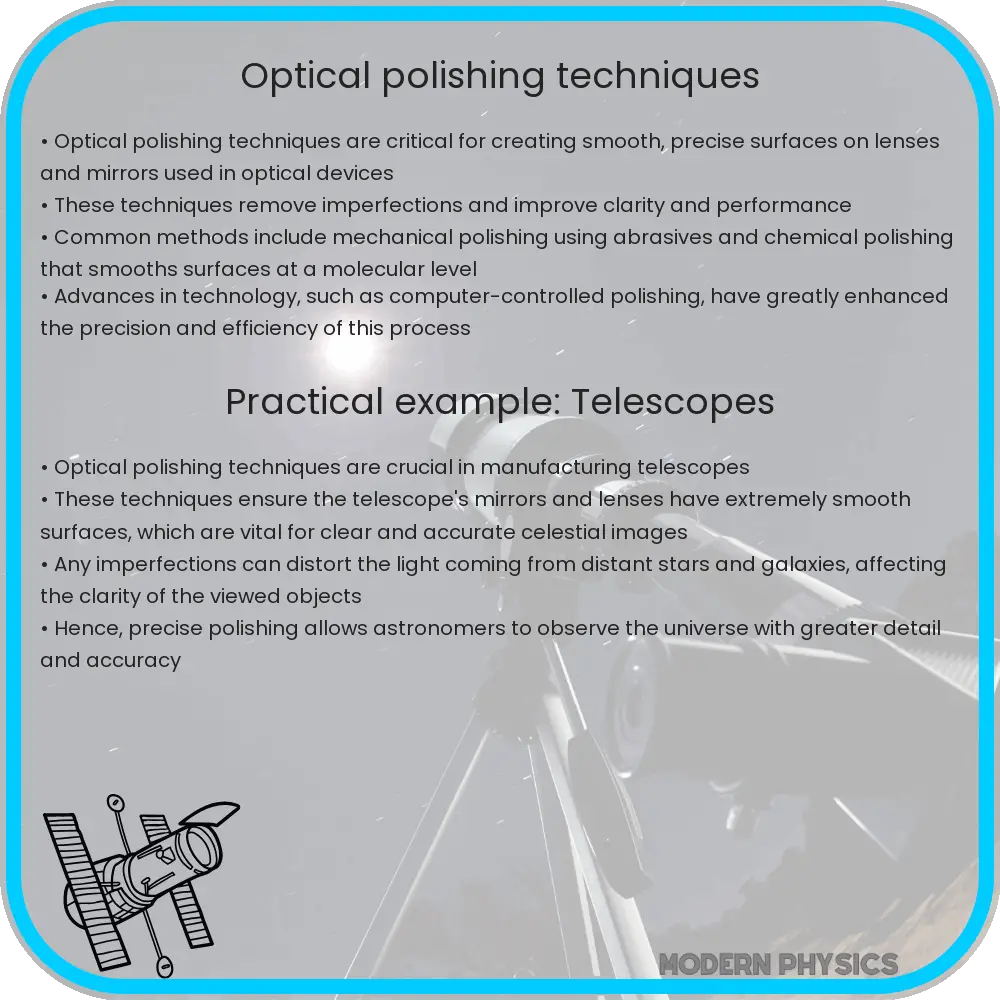Explore advanced optical polishing techniques for precision, clarity, and efficiency in this article, covering MRF, IBF, CMP, and quality control.

Introduction to Optical Polishing Techniques
Optical polishing is a critical process in the manufacture of lenses, mirrors, and other optical components. It involves removing the surface material from an optical component to achieve a desired level of smoothness and clarity. This process is essential for applications requiring high precision and efficiency in optics, such as telescopes, microscopes, and laser systems. The goal of optical polishing is not only to enhance the optical performance of a component but also to minimize light scattering and absorption, which can degrade the quality of the transmitted or reflected light.
Key Techniques in Optical Polishing
Several techniques are employed in the optical polishing process, each suitable for different materials and applications. The most commonly used methods include:
- Mechanical Polishing: This method uses a rotating polishing pad and an abrasive slurry to remove material from the optical surface. The abrasives commonly used include cerium oxide (CeO2), aluminum oxide (Al2O3), and silicon carbide (SiC). Mechanical polishing is highly effective for initial rough polishing to remove major surface imperfections.
- Chemical Mechanical Polishing (CMP): CMP combines mechanical polishing with chemical reactions to achieve ultra-smooth surfaces. This technique is particularly useful for polishing semiconductor materials and optical components with complex geometries.
- Magnetorheological Finishing (MRF): MRF is a computer-controlled polishing process that uses a magnetorheological fluid containing magnetic particles and abrasive grains. The fluid’s viscosity changes in response to a magnetic field, allowing for precise control over the polishing pressure and rate. MRF is ideal for correcting surface irregularities and achieving high-precision surfaces.
Each of these techniques can be tailored to meet the specific requirements of the optical component being polished, taking into account factors such as material properties, desired surface finish, and optical performance criteria. The choice of polishing method depends on the balance between efficiency, cost, and the precision required for the application.
Importance of Precision, Clarity, and Efficiency
Precision and clarity are paramount in optical polishing, as they directly impact the performance of the optical component. A precisely polished surface ensures that light is transmitted or reflected as intended, maximizing the efficiency of the optical system. Efficiency in the polishing process also plays a critical role, as it affects production time and cost. Advances in polishing technologies continue to improve the precision, clarity, and efficiency of optical components, contributing to the advancement of optical science and technology.
Advanced Techniques in Optical Polishing for Enhanced Precision and Clarity
The art and science of optical polishing have evolved significantly, driven by the relentless pursuit of perfection in precision optics. High-quality optical components are crucial across various industries, including aerospace, defense, medical devices, and consumer electronics. These components must exhibit exceptional clarity, precision, and efficiency in their function. Advanced optical polishing techniques are at the heart of achieving these stringent requirements.
Substrate Preparation and Rough Polishing
Optical polishing begins with meticulous substrate preparation. The choice of substrate material, typically glass, quartz, or silicon carbide, sets the foundational quality of the optical component. Initial rough polishing removes major surface imperfections and prepares the substrate for fine polishing. This stage is critical for shaping and smoothing the surface, using progressively finer abrasives to achieve a near-perfect form.
Precision Polishing Techniques
Following rough polishing, precision polishing techniques take over to achieve optical-grade finishes. Techniques such as Magnetorheological Finishing (MRF) and Ion Beam Figuring (IBF) offer unparalleled control over surface topology. MRF, for instance, uses a magnetically responsive slurry to precisely abrade the optical surface, enabling the correction of minute surface irregularities. IBF, on the other hand, employs a directed ion beam to gently remove surface material, allowing for atomic-level precision.
Chemical Mechanical Polishing (CMP)
Chemical Mechanical Polishing (CMP) represents a hybrid approach, combining mechanical abrasion with chemical etching. This technique is particularly effective for materials like Silicon (Si), where achieving ultra-smooth surfaces is critical. By carefully balancing the chemical and mechanical interactions, CMP can produce surfaces with roughness on the order of angstroms.
Inspection and Quality Control
The final stage of optical polishing is rigorous inspection and quality control. Advanced metrology tools, including interferometers and atomic force microscopes (AFM), are employed to measure surface quality, ensuring that the optical components meet the high standards required for their intended application.
Conclusion
Modern optical polishing techniques, combining mechanical, chemical, and advanced computational methods, have revolutionized the production of precision optics. These methods not only enhance the performance and efficiency of optical components but also push the boundaries of what is achievable in optical clarity and precision. As technology advances, the demand for higher quality optics will continue to grow, and the techniques discussed here will play a crucial role in meeting these evolving needs. Through continuous innovation and refinement, the field of optical polishing ensures that industries dependent on high-quality optics can look forward to a future where the limits of precision and clarity are constantly being redefined.
